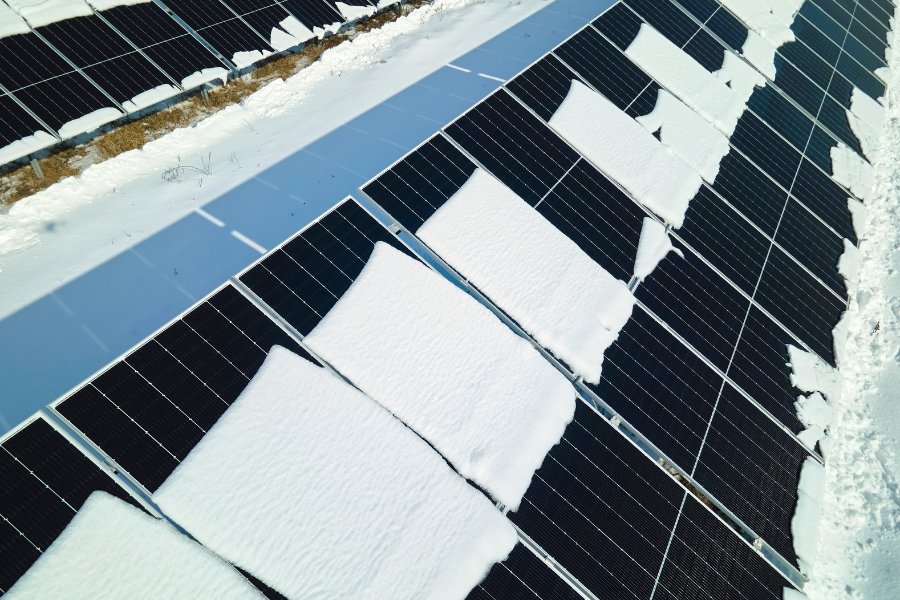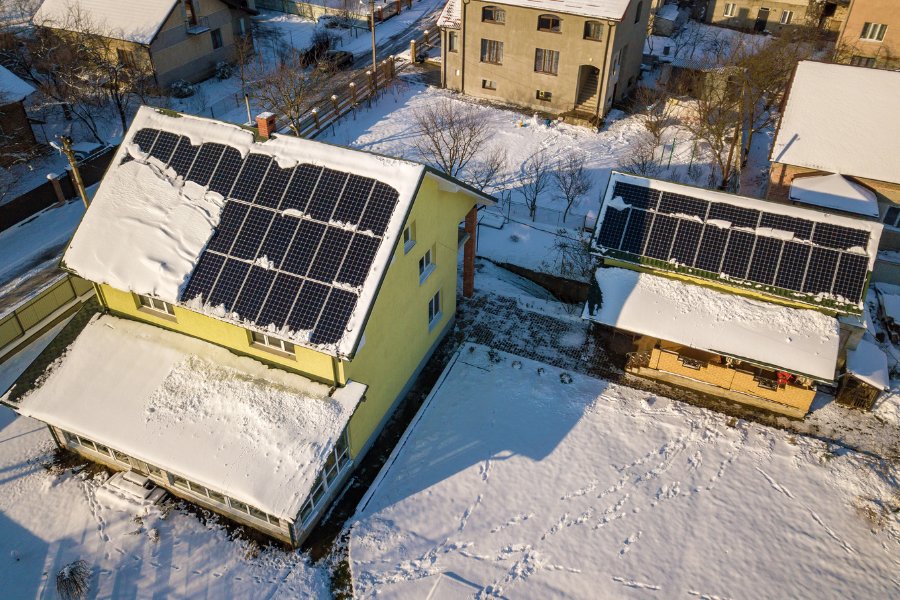Snow on solar panels raises a lot of questions. How much energy is lost when panels are covered? Can heavy snow damage the system? Do I need to remove snow manually? These are common concerns, but the answers are much more simple than most people realize, and cold temperatures actually bring some benefits to solar production. Snow affects solar panels in several ways: by temporarily blocking sunlight, adding weight, and even reflecting light. However, panels are designed for heavy snowfalls.
How Snow Affects Solar Panels and Energy Production
Snow directly impacts solar panels by blocking sunlight. When light can’t reach the photovoltaic cells, the electricity production drops. The extent of the drop depends on the snow’s thickness, moisture content, and how long it stays on the panels. Light, dry snow often slides off within hours, while wet, heavy snow can stick for days.
Even a complete snow cover is temporary. Solar panels generate a small amount of heat during operation, which helps melt snow from the surface. This process, combined with sunlight, usually clears panels naturally. The angle of your panels also matters. Panels installed at steeper angles shed snow faster than flat or gently sloped panels.
Partial Snow Coverage and Energy Output
Snow rarely covers every panel evenly. This is why you may see panels staggered at different heights in solar power for residential and commercial buildings, so that snow doesn’t cover them all. Partial coverage can reduce output unevenly, but modern systems are designed to handle this. Microinverters and power optimizers allow panels to operate independently, so shaded panels don’t drag down the performance of the entire system.

Can Snow Damage Solar Panels?
Snow itself is rarely a threat to solar panels. The threat comes from ice, debris, and pooling water. Panels are engineered to handle significant weight, typically far more than a few inches of snow. Heavy snow accumulation followed by sudden melting and refreezing can put stress on mounting hardware. That’s why it’s important to check roof edges, gutters, and downspouts before winter. If water can’t drain, it can cause pressure points. Routine inspections reduce the risk of issues developing underneath snow.
How Snow Interacts with Solar Panel Materials
Solar panels are weather-tested, so the materials used in solar panels handle cold and moisture really well. Tempered glass is strong and resistant to thermal expansion. Aluminum frames tolerate temperature shifts without warping. Photovoltaic cells continue functioning at low temperatures, often even with slightly improved efficiency. Cold conditions actually improve the electrical performance of silicon-based cells, though the snow covering them temporarily blocks sunlight.
Snow and Albedo: Snow as a Natural Reflector
As we all may know, snow reflects light. This is called albedo. The bright white snow acts like a mirror, directing extra light onto the panels. In some cases, this effect can slightly offset the lost energy from snow-covered panels, giving an energy increase even when the system isn’t in full sun. Albedo is more noticeable with fresh, powdery snow. Older, dirty snow reflects less light, but the effect is still present. So, believe it or not, snow is not harmful to solar panels and can actually help with energy production.
How Cold Temperatures Affect Solar Panels
Most people assume cold weather reduces solar production, but it doesn’t! Photovoltaic cells actually perform better in cooler temperatures. Electricity flows more efficiently when the cells are cold, which slightly increases output compared to sunnier days. The main limitation for solar panels isn’t temperature, it’s sunlight. Shorter days and low sun angles reduce total energy production, but the cold itself is not a problem at all.
The Physics of Snow Sliding Off Panels
Snow doesn’t just melt, it slides. How quickly it does depends on panel angle, surface texture, and snow type. Steeper panels encourage snow to slide naturally. Smooth, tempered glass also helps snow release more easily. Dry, powdery snow moves faster than wet, heavy snow, which sticks and can form icy layers.
Some homeowners notice that snow slides in strips or patches. That happens because heat from the panels melts small areas first, creating weak points where snow begins to break away. Understanding this process can help you predict when panels will clear themselves and why some areas may stay covered longer.

Safe Snow on Solar Panels Removal Practices
Snow on solar panels rarely needs to be removed. If energy output is critically low for several days, light removal can help if you can easily reach it. Use a soft, non-abrasive tool on the ground. Plastic roof rakes designed for solar panels are best. Avoid metal tools and never climb onto the roof.
Clear in layers rather than trying to scrape all the snow at once. Heavy snow removal attempts can damage panels or void warranties. Solar panels are designed for snow, so let gravity and sunlight do the work whenever possible!
Monitoring During Snowy Periods
Keeping an eye on energy production is key here. If the system shows persistent low output after the snow melts, it could indicate ice blocking some panels or a technical issue. Monitoring systems provide real-time feedback.
Understanding Winter Solar Panel Performance
It’s normal to see a dip in production during winter. Snow, shorter days, and low sun angles all play a role. In many areas of New York City, solar panels still produce electricity at a meaningful rate. Over the year, winter reductions are offset by higher production in spring and summer.
Winter performance doesn’t indicate a problem unless output remains low after snow has melted. That’s when a system check is appropriate. The panels themselves are built so resiliently and are designed to handle all seasons without issues.
